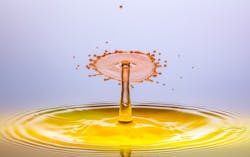The Vision for UV
Ron Hofmann is president of the International Ultraviolet Association (IUVA). Oliver Lawal is past president for IUVA. Jennifer Osgood is president-elect for IUVA. Hofmann can be reached at [email protected]. Lawal can be reached at [email protected]. Osgood can be reached at [email protected].
undefinedWater treatment using ultraviolet (UV) light has been around for many years, and it is a robust and effective technology.
That being said, there are still many unknowns about its application, as well as opportunities for improvement. As a professor at the University of Toronto, it is part of my job to keep track of the issues being discussed and how they might affect its evolution.
Some of the more interesting innovation is happening in the context of drinking water treatment by UV. One area of investigation is specific to polychromatic (medium pressure) UV lamps, which emit light at many wavelengths compared to monochromatic (low pressure) mercury lamps that emit primarily at 254 newton-meters. Many of the ways that we control and monitor UV reactor performance was biased towards the monochromatic systems, so there are ongoing discussions in the research community about how best to modify our approaches to allow medium pressure systems to be controlled more efficiently.
Furthermore, we are learning that some of the other wavelengths offer benefits in terms of additional disinfection of pathogens that maybe have not been properly accounted for in our current assessment of UV performance. This whole issue of how different wavelengths of UV light perform differently might become even more important in the future if UV Light Emitting Diodes (LEDs) begin to penetrate the municipal market. UV LEDs can be tuned to different wavelengths, which could provide various optimum combinations of wavelengths to address specific treatment needs. We still have a lot to learn on this topic.
Another interesting emerging area of UV application is for advanced oxidation (AO) in which an oxidant such as hydrogen peroxide or chlorine is added to water and then exposed to powerful UV light to form hydroxyl radicals. These hydroxyl radicals can destroy many otherwise recalcitrant pollutants. An example of UV-AO is for potable reuse treatment. At several locations in southern California, municipal wastewater is further purified using reverse osmosis (RO) followed by UV-based advanced oxidation, with the resultant water meeting potable standards. The rationale for this treatment train is that RO does not removal all chemical contaminants, and the UV-AO process serves as a second barrier against those chemicals, as well as offering additional UV disinfection. UV-AO processes are well understood but there are some remaining unknowns. For example, there is the potential for byproducts to be formed that must be considered, and methods to monitor AO performance online in real time as a function of potentially varying water quality parameters could be improved.
Overall, UV light is a mature water treatment technology that is well understood and can be implemented with quite predictable results. The research aims primarily to make refinements and incremental improvements to what is already an important and effective tool to treat our municipal drinking and wastewater.
Picking up on the topic of UV LEDs, all new technologies have a combination of factors driving their commercial success. They must solve a real problem, be available at an acceptable price/value ratio, and be fully reliable over the service life. UV-C LED technology implementation for water and wastewater treatment can be measured by these criteria.
Solve a Real Problem
UV water treatment has grown strongly over the past decades; however, mercury-vapor lamps do have certain operational limitations (large footprint, start-up time, cycling restrictions, heat generation, replacement intervals, footprint, mercury content). In theory, UV-C LEDs provide an equal level of disinfection benefit, while overcoming the operational limitations. This results in the possibility to replace traditional UV technology with UV-C LED technology.
It is not a simple engineering task to replace a mercury-vapor lamp with a UV LED lamp—imagine doing a quick switch of a petrol or diesel engine with batteries—or changing the screen on a 1990’s TV with LEDs. Currently, point-of-use (POU) water treatment systems have been engineered and are being commercially sold in the tens-of-thousands. Point-of-entry (POE) systems will come onto the market in 2020. For centralized water treatment systems there are a few companies just starting pilot-scale trials to validate larger scale engineering solutions.
Price/Value Ratio
The first commercial UV-C LED product had a $12,000 build cost in 2012 for a disinfection flow rate of around 2 lpm. The same performance was around $1,000 in 2015 and now in volume supply for less than $50. The core function has not changed, but the value has increased dramatically as the manufacturing cost of UV-C LED devices has dropped. It will be interesting to see how the larger scale pilot systems compare on a Capex and Opex basis. This author feels when considering total lifecycle costs, that UV LED technology will start to be competitive in smaller municipal applications in two to three years.
Reliability
Mass production supply demands that manufacturers establish strong supply chains and product assembly processes—something that is in evidence today with several UV LED equipment suppliers. We already see third-party certifications like CE, UL, IEC and ISO in place. Late in 2019, NSF International made a huge leap by releasing an update to Standard 55 that allows for the use of LED technology. One manufacturer already has five models listed on the NSF certification database, and 2020 will certainly bring more product listings. With thousands of POU systems produced each month, the engineering reliability is being proven in low flow applications, prior to entry into larger flow applications.
We have just scratched the surface of these new innovative deployments of UV LEDs in water treatment and we will see increasingly sophisticated embedding of the technology in residential, commercial, medical and transportation applications. It will be interesting to see if the Minamata 2020 Convention will have any impact on the UV industry. Now ratified by the United Nations, this convention seeks to reduce the use of mercury in products; however, exemptions currently exist for water and wastewater applications. It could be that the viability of UV LED solutions impacts these exemptions over time, though almost certainly not homogeneously across the globe and applications.
It seems clear that UV LED technology has a bright future in the disinfection market. The ability to reliably solve a broader range of problems within a viable price and value ratio is hard to bet against. The question is more regarding timing.
What an experience to watch the UV industry evolve over the past decade, specifically in the application for drinking water treatment. Initially, the Long Term 2 Enhanced Surface Water Treatment Rule (LT2) triggered many UV disinfection installations across the U.S. Furthermore, when utilities conducted Round 2 samples of LT2, several recognized higher Cryptosporidium levels that prompted more UV disinfection installations across the UV.
For utilities that already had UV installed and also experienced increase in Cryptosporidium levels with Round 2 sampling, an increase in UV dose was necessary. New York, Boston, San Francisco, Seattle, and Portland, Maine, are all unfiltered water supply systems using UV disinfection to meet LT2. Whether UV disinfection is being used for inactivation of Giardia lamblia cysts or Cryptosporidium oocysts, or as a multi-barrier approach, UV is a widely accepted cost-effective treatment.
Changes in lamp technology, reactor options, validation techniques, and challenge microorganisms along with an increase in knowledge about UV technology by the regulatory and municipal communities aided to the number of installations and provided more economical UV solutions.
The evolution of the UV industry will continue to trend toward smaller, more powerful systems that will enhance water quality.



